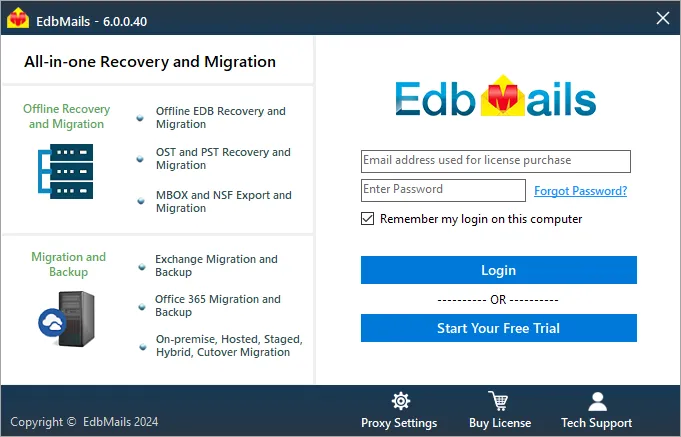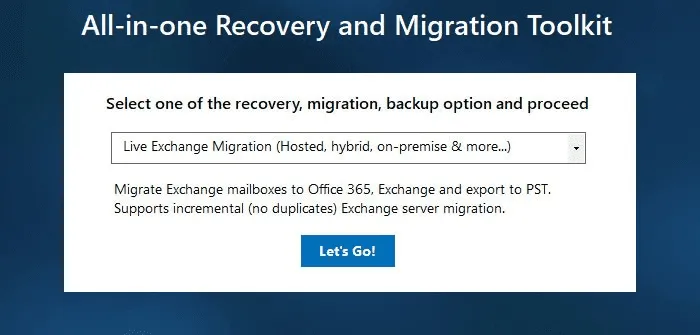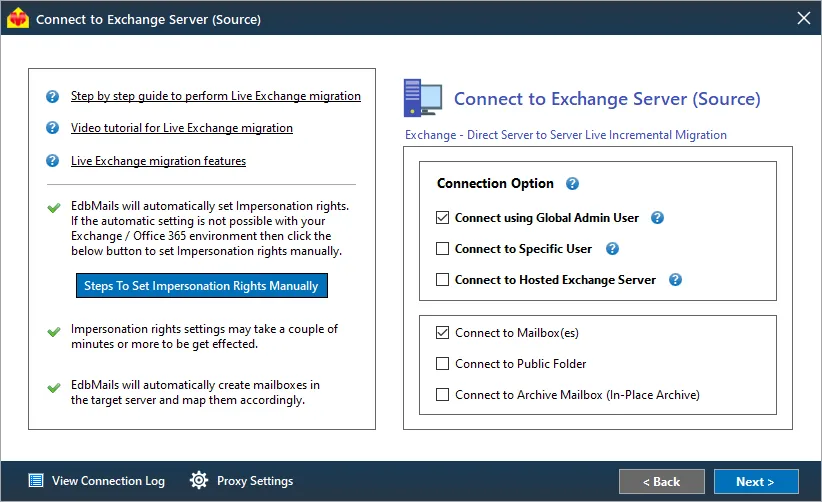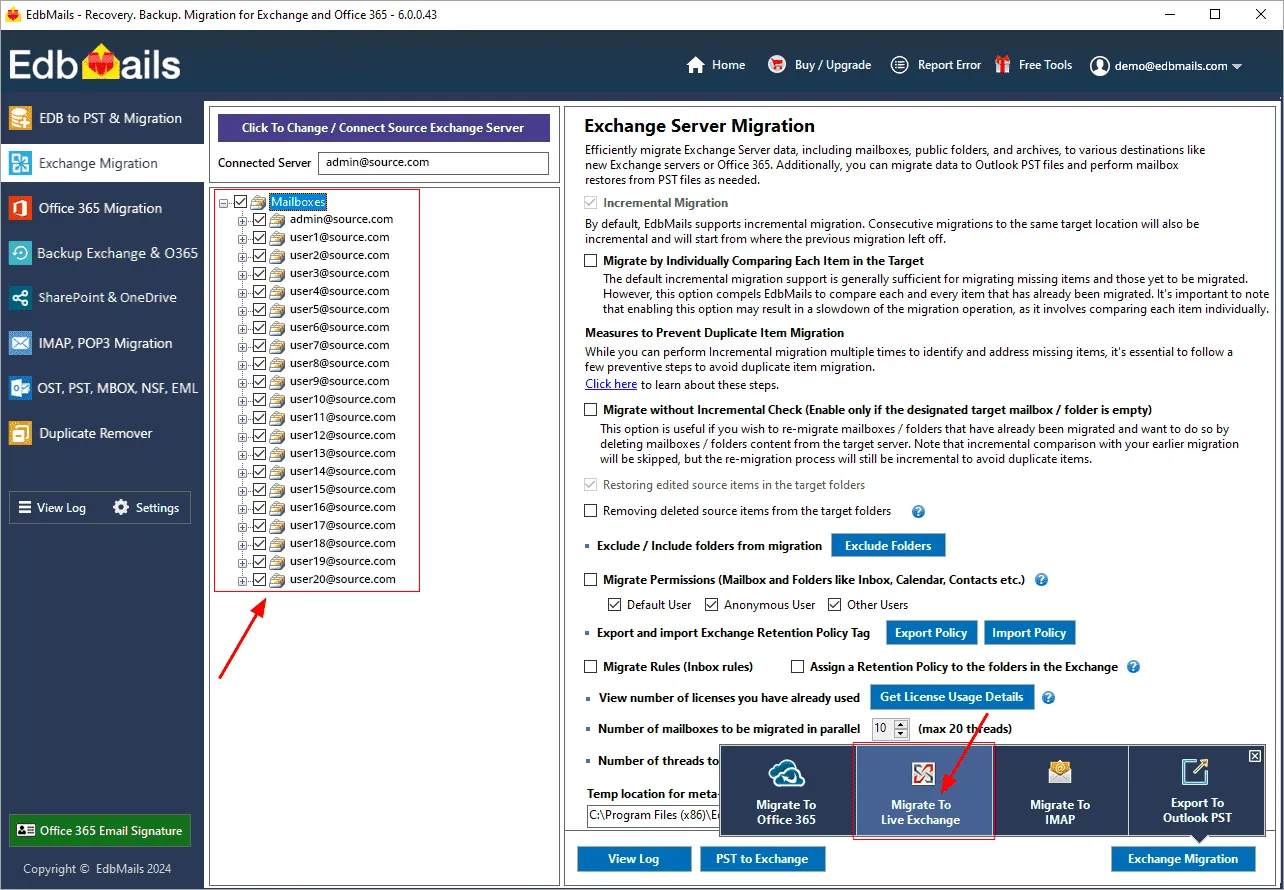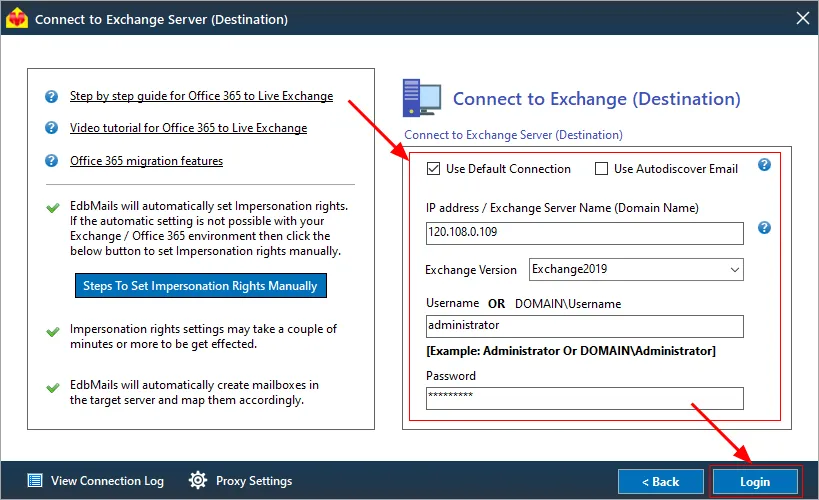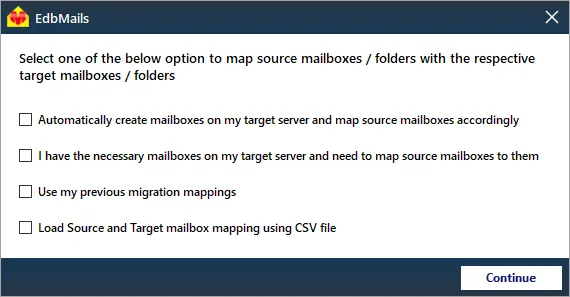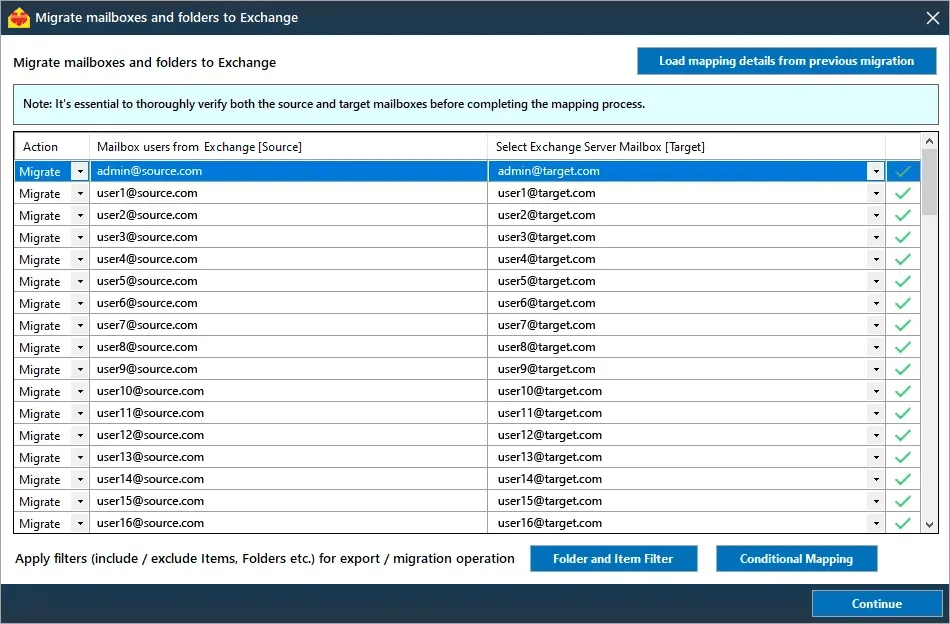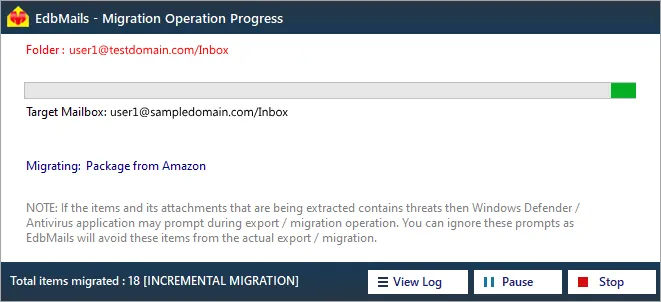Migrate Exchange 2016 to 2019
Migrating from Exchange Server 2016 to 2019 might feel familiar since the overall structure remains similar. However, Exchange 2019 brings key improvements like the MetaCache Database (MCDB), which boosts performance by caching frequently accessed data on SSDs, and Dynamic Database Cache (DDC), which adjusts cache size based on usage to improve efficiency.
EdbMails Exchange migration software simplifies the migration process from Exchange 2016 to 2019. It supports the direct migration of mailboxes, Public folders, and Archive mailboxes, automating much of the work to ensure that your data moves effortlessly to the new Exchange environment.
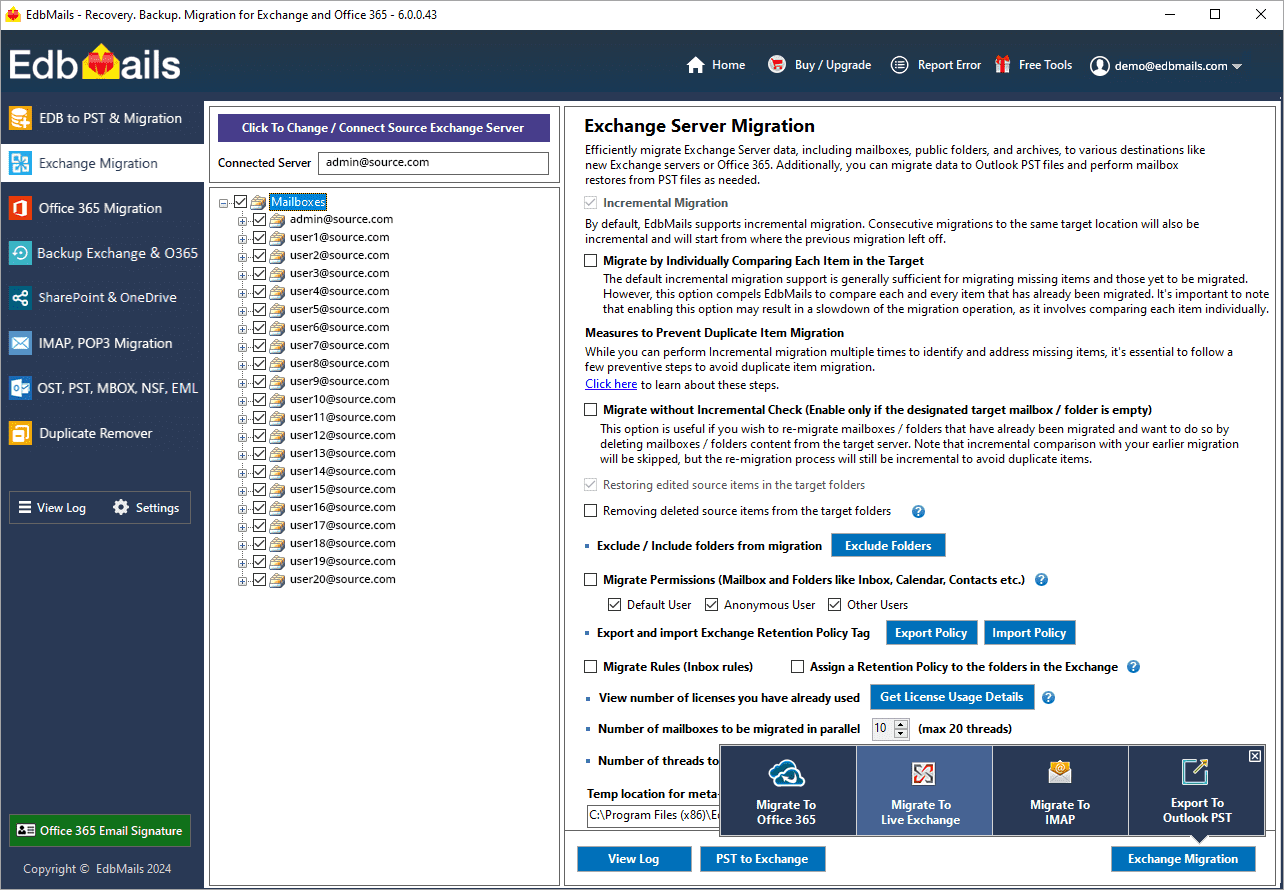
EdbMails offers several advanced features to make the migration smoother. Incremental migration transfers only new or modified data, preventing duplication. Concurrent mailbox migration allows multiple mailboxes to be migrated at once, reducing the overall time required. Automatic mailbox mapping automatically matches source mailboxes to their targets, avoiding manual setup, Automatic throttling management handles server limits efficiently, ensuring a steady migration process without interruptions.
With these features and user-friendly automation, EdbMails is a reliable and efficient tool for individuals and organizations migrating from Exchange 2016 to 2019.
The following sections cover complete step by step procedure for Exchange 2016 to 2019 migration operation
Reasons to migrate Exchange 2016 to 2019
If you're considering using Exchange 2016 or 2019, there are a few key points to keep in mind. Microsoft ended mainstream support for Exchange 2016 on October 13, 2020, with extended support set to conclude on October 14, 2025.. After the extended support date, no further updates or security patches will be released for Exchange 2016, making it advisable for organizations to migrate to a newer version if they wish to continue receiving support and updates from Microsoft. Below are some of the enhancements in Exchange 2019 compared to Exchange 2016.
Exchange 2019 offers significant improvements over its predecessor, including enhanced performance, better user experience, and improved security features. Organizations should consider these advancements when planning their migration strategy, and the EdbMails Exchange migration tool can facilitate a smooth migration to take full advantage of these upgrades.
Enhanced security
Exchange 2019 introduces advanced security measures, including support for Windows Server Core, upgraded encryption protocols, and robust data loss prevention mechanisms. EdbMails Exchange migration software ensures that your data is securely migrated while maintaining compliance with these new security standards, giving organizations peace of mind during the transition.
Optimized performance
Exchange 2019 provides enhanced performance through its MetaCache database, improved search infrastructure, and greater scalability compared to Exchange 2016. These advancements make it exceptionally well-suited for large organizations with significant email usage requirements. EdbMails Exchange Migration software designed to optimize the migration process, ensuring that performance improvements are realized quickly and efficiently.
Revamped mailbox experience
Exchange 2019 brings forth new capabilities, such as modern attachments, which enable users to share OneDrive file links instead of sending actual copies. This feature not only optimizes mailbox storage but also fosters improved collaboration among users. By using EdbMails, organizations can ensure that all mailbox data, including these new features, is transferred accurately, preserving the enhanced user experience.
Advanced Public folder support
Exchange 2019 offers enhanced support for modern public folders, integrating them with the In-Place eDiscovery and Hold workflows. This integration ensures improved search performance and scalability, providing a more effective solution compared to traditional public folders for organizations. The EdbMails Exchange migration tool seamlessly migrates public folders, ensuring that all data is retained and optimized for the new environment.
Enhanced Hybrid deployment support
Exchange 2019 features upgraded capabilities for hybrid deployments, including a cloud-based Hybrid Configuration Wizard (HCW). This improvement simplifies the migration process to Office 365 for organizations, facilitating a smoother transition. With EdbMails Exchange migration software, users can easily perform migration in a Hybrid environment.
Beyond the new capabilities introduced in Exchange 2019, it is important to consider and know what has been discontinued in 2019.
Exchange 2016 and 2019 coexistence
Exchange 2016 and Exchange 2019 can coexist within the same active directory setup. Nevertheless, it is crucial to take into account specific factors to guarantee their seamless coexistence.
Application integration
Confirm that all software used in your organization is compatible with Exchange 2019. This encompasses email clients, antivirus solutions, backup tools, and monitoring systems to ensure smooth operation and effective integration.
Cumulative updates
Ensure that your Exchange 2016 servers, including Edge Transport servers, have Cumulative Update 11 or a later version installed for optimal performance and compatibility.
System requirements
Exchange 2019 has distinct hardware and software prerequisites that must be fulfilled for proper installation and operation. This includes specifications for the operating system, processor type and speed, as well as memory. Be sure to address these requirements prior to initiating the migration process.
Licensing considerations
When upgrading from Exchange 2016, it is crucial to verify that you possess the appropriate licenses for Exchange 2019.
Best software to migrate Exchange 2016 to 2019
Other methods of migrating from Exchange 2016 to 2019, such as manual mailbox transfers, built-in migration tools, PowerShell scripts, or importing PST files, can present significant complexities. These approaches often involve intricate configurations, require extensive command-line knowledge, and may carry risks of data loss, potentially leading to extended downtime. For instance, while PST imports can be useful for transferring individual mailboxes, they often result in lengthy processes and additional steps for data integrity checks. Organizations without dedicated IT resources may find these methods particularly challenging, as they necessitate a deep understanding of both the source and target environments to execute successfully.
In contrast, EdbMails Exchange migration serves as a comprehensive solution that effectively addresses these challenges. It simplifies the migration process by facilitating the seamless transfer of all mail data, including user folders, public folders, contacts, calendars, permissions, emails, tasks, journals, notes, and more, while ensuring complete data consistency. EdbMails not only supports migrations between Exchange versions but also supports migrations to Office 365, and Hosted Exchange server. Additionally, it features an intuitive user interface that eliminates the need for technical knowledge, making it accessible for organizations of all sizes.
Exchange 2016 to 2019 migration checklist
Here’s a checklist to consider when transitioning from Microsoft Exchange server 2016 to 2019:
- Ensure your existing Exchange server environment meets the necessary prerequisites for installing Exchange server 2019. Confirm the versions of both Exchange and Windows server in use.
- Communicate any potential changes to end users and stakeholders.
- Assess the costs associated with migration, as well as the required network infrastructure and bandwidth.
- Proceed with the installation of Exchange server 2019 on your server, including any additional roles and permissions.
- Set up the new Exchange server 2019 environment by creating mailboxes, public folders, and client access rules.
- Conduct thorough testing of the new Exchange server 2019 environment to verify its proper functionality.
- Migrate mailbox and public folder data from the previous Exchange server 2016 environment to Exchange 2019 using EdbMails.
- After successful migration and testing, decommission the old Exchange server 2016.
Exchange 2016 to 2019 migration prerequisites
- Step 1: Check that your system meets the Exchange 2019 setup requirements.
Before you migrate Exchange 2016 to 2019, ensure that your current environment and hardware is compatible for the migration. The following links will help you to know about the hardware, network, .NET framework and operating system requirements for installing Exchange server 2019.
- Network and directory requirement for Exchange 2019
- Hardware Requirements for Exchange 2019
- Supported operating systems for Exchange 2019
- Supported .NET Frameworks for Exchange 2019
- Supported Outlook clients in Exchange 2019
- Lync/Skype Business Server integration with Exchange 2019
Exchange server version Coexistence scenario Requirement Migration Exchange 2019 Possible. Can coexist with Exchange 2016 Install Cumulative Update 11 (CU11) or later on Exchange 2016 EdbMails can help you migrate Exchange 2016 to Exchange 2019 directly Additional Notes:
- Exchange 2019 requires Active Directory forest functional level of Windows Server 2012 R2 or higher.
- The Domain Controllers need to be running on Windows Server 2012 R2 Standard or Datacenter and higher.
- You must install .NET Framework 4.8 on a Cumulative Update (CU) of 4 to 12.
- The Mailbox and Edge Transport servers require Windows Server 2019 Standard or Datacenter and higher. See the Exchange server 2019 supportability matrix for more information.
- Step 2: Prepare your system with the following prerequisites for Exchange 2019
Complete the following prerequisites for Active Directory, Windows 2019 Mailbox server, and Windows 2019 Edge Transport servers before installing Exchange server 2019.
- Step 3: Determine the migration path from Exchange 2016 to 2019
Evaluate whether a staged, cutover, or hybrid Exchange migration suits your needs. EdbMails facilitates these migrations seamlessly, ensuring zero server downtime or data loss. Notably, it allows continued mailbox usage throughout the migration process, eliminating the need to disconnect your Exchange server.
Current environment and requirement Ideal migration approach Migration flow You want to perform a full migration to Exchange 2019 in a single event and in a limited time frame. Exchange 2016 to 2019 cutover migration Set up your target Exchange server and migrate everything in a single sitting. Suitable for large number of mailbox migration You have little time and want to migrate mailboxes in phases or over the weekends Exchange staged migration Migrate your mailbox data in stages and transfer the most recent data first followed by the others. You want to migrate Exchange 2016 mailboxes to a Hybrid 2019 and Office 365 environment Migrate Exchange 2016 to 2019 Hybrid Migrate from the source server to a Hybrid Exchange and Office 365 environment. Note: The migration path depends on the number of mailboxes you want to migrate, size of the data and your organizational requirements. Use the Exchange deployment assistant to help you decide on the path.
- Step 4: Set up the target Exchange server 2019 for migration
The following is a list of key points for installing and preparing the Exchange 2019 server for migration:
Note: If you have already installed and configured Exchange 2019 in the target environment, proceed to step 4.
- Prepare the Active Directory forest and domains
- Before installing Exchange Server 2019, prepare your Active Directory forest and its domains for the new version of Exchange.
- If you have a separate team to manage the Active Directory schema, you must extend the active directory schema, else proceed to the next step to prepare the Active Directory.
- If you have multiple domains you need to additionally prepare the Active Directory domains.
- Install Exchange server 2019
Ensure that you meet the server system requirements and prerequisites as outlined previously. Next, install Exchange 2019 mailbox server and edge transport server using the setup wizard. Microsoft recommends installing Exchange 2019 on Windows Server core for best experience.
- Prepare a clean Exchange 2019 target environment
- Install and upgrade Exchange 2019 to the latest cumulative update to keep your server up to date.
- Create and configure a Send connector to send mail outside the Exchange organization.
- By default, Exchange automatically creates receive connectors for inbound mail flow when the mailbox server is installed. However, if you want to configure custom receive connectors for certain mail flow scenarios, follow the steps in the link.
- Add accepted domains to allow recipients to send and receive email from another domain.
- Configure the default email address policy to add the accepted domain to every recipient in the organization.
- Configure external URLs (domains) on the virtual directories in the Client Access (frontend) services on the Mailbox server to allow clients to connect to your server from the internet (outside the organization’s network).
- Configure internal URLs on the virtual directories in the Client Access (frontend) services on the Mailbox server to allow clients to connect to your server from the internal network.
- Configure SSL certificates from a third-party certificate authority for services such as Outlook Anywhere and Exchange ActiveSync.
- Verify the Exchange server installation by running the command Get-ExchangeServer on the Exchange Management Shell (EMS)
- Create mailboxes and Public folder on Exchange 2019 server
Ensure that mailboxes are created on the target Exchange 2019 server. You can choose to allow EdbMails to automatically create mailboxes on the target server. However, if you prefer to create mailboxes manually, refer to the link below:
Steps to create mailboxes in Exchange server
If you are planning to migrate public folders from Exchange 2016 to 2019, ensure that public folders are created on the target server and that admin permissions are assigned on both the source and target servers.
- Install cumulative updates (CU) on Exchange server 2016
For Exchange 2016 to 2019 migration, ensure to install the latest cumulative updates (CU) on the source 2016 server.
- Create trust relationship between forests (Optional)
A forest trust is an authentication between two domains within the same Active Directory forest which creates a trust between two root domains for exchanging information. By creating a trust in advance, it is possible to address the trust issues during or after the migration.
Note: This step applies to Windows Server 2008, Windows Server 2008 R2 and Windows Server 2012. Creating a trust relationship is not required for SBS based environments.
- Assign management roles to the admin account
Ensure that you have set the following permissions to the admin account on the source (2016) and target server (2019)
- On the source
- ApplicationImpersonation
- View-Only Configuration - Run the cmdlet New-ManagementRoleAssignment using the Exchange Management Shell to assign the View-Only Configuration role to the admin.
- Organization Management role group. It is an elevated permission that is required to migrate Public folders.
- On the target
- ApplicationImpersonation
- View-Only Recipients
- View-Only Configuration
- On the source
- Verify the mailbox of the admin account
Check to see if the admin account that has been assigned management roles has a valid and non-hidden mailbox on the Exchange 2016 server.
- Configure the throttling and message-size limits
Change the EWS throttling and message size limits on the target Exchange 2019 server by following the steps outlined in the links.
- Prepare the Active Directory forest and domains
- Step 1: Check that your system meets the Exchange 2019 setup requirements.
Steps to migrate Exchange 2016 to 2019
Step 1: Download and install EdbMails Exchange migration tool
- Download and install the EdbMails application on any computer running Windows operating system and that can be connected to both source and target Exchange servers.
- Once installed, open the EdbMails application and click either 'Login' entering the appropriate details or 'Start Your Free Trial' to proceed.
- Explore the complete set of system requirements to facilitate Exchange 2016 to 2019 migration.
Step 2: Select Exchange migration operation
From the dropdown menu, select the 'Live Exchange Migration' option
Step 3: Connect to the source Exchange 2016 server
- In the 'Connect to Exchange server (Source)' window, select the preferred connection option
- Discover more information on the different connection methods that EdbMails supports.
- EdbMails allows the migration of mailboxes, public folders, and archive mailboxes from the source Exchange 2016 server to the target Exchange 2019 server.
- To connect to your Exchange server, you can use the ‘Default Connection’ option, which requires you to provide the Exchange server name, version, and your login details. Alternatively, you may select the ‘Autodiscover email option’ for a direct login using your email address and password.
- After a successful login, you can choose to load mailboxes. EdbMails provides an automated mailbox loading feature. Also, You have the option to manually load mailboxes using a CSV file.
Step 4: Select Exchange 2016 mailboxes
- Select the Exchange 2016 mailboxes and folders in the left pane of the main migration window.
Tip: If this is your first migration using EdbMails, it will be a full migration. For any subsequent migrations from the same source to the target, the process will be incremental, meaning it will only migrate new or modified data that was not included in the previous migration operation.
- Click 'Migrate to Live Exchange'
- Select the Exchange 2016 mailboxes and folders in the left pane of the main migration window.
Step 5: Connect to target Exchange server 2019
- In the 'Connect to Exchange server (Destination)' window, choose the required connection option and click ‘Next’
- Enter your target Exchange 2019 server details and click the ‘Login’ button
- Once you've successfully logged in, select the required option for loading the target Exchange 2019 server mailboxes.
Step 6: Exchange 2016 to 2019 mailbox mapping
- Choose the required mailbox mapping option
- If you install EdbMails on your target Exchange server, you can choose to automatically create mailboxes on the target Exchange server.
Click here to know more about automatic mailbox creation.
- EdbMails automatically maps mailboxes between the source and target Exchange servers. This feature is particularly helpful when migrating numerous mailboxes, as it reduces manual effort and saves time during the overall migration process.
- Click the ‘Folder and Item Filter’ button to customize the migration operation. For example, you can migrate only the emails or other mailbox items that are sent or received within a certain data range using date filter.
Step 7: Start Exchange 2016 to 2019 migration
After the mailbox mapping, click the ‘Continue’ button, enter a job name, and proceed. Once the migration has been completed, EdbMails will display a message indicating migration success. Click the 'View Log' button to view the migration report. Additionally, ensure you log in to your target server to verify that the items have been migrated successfully.
Exchange 2016 to 2019 post-migration tasks
- Step 1: Update the MX records to point to Exchange 2019 server
To receive messages on the Exchange server 2019, update the MX records to enable email to work with the new server you have migrated to. In addition, configure the Autodiscover record to allow Outlook to connect to the migrated mailboxes.
- Step 2: Create a new Outlook profile for users in the new domain
Ensure that you have the latest version of Outlook that is supported with Exchange 2019. Configure the Outlook profile for each user in your domain if Outlook has problems connecting to the new Exchange server.
- Step 3: Decommission and uninstall Exchange server 2016
Wait for a few days to check that you’re receiving emails correctly and that everything is working as expected and finally decommission the source server.
Steps to decommission Exchange 2016 server:
- Remove all connectors that were configured on the Exchange 2016 server.
- Remove the Exchange 2016 server from the list of accepted domains on Exchange 2019.
- Remove the Exchange 2016 servers from the network and uninstall any Exchange-related components.
- Remove the Exchange 2016 server from the Exchange organization.
- Uninstall the Exchange 2016 software from the Control Panel.
- Remove the server from the Active Directory domain.
- Reclaim the server's license.
Note: Test the migration thoroughly and ensure that all data and configurations have been successfully transferred to the new server. It is recommended that you contact Microsoft Support before decommissioning Exchange 2016 for your organization.
- Step 1: Update the MX records to point to Exchange 2019 server
Exchange 2016 to 2019 migration troubleshooting
Please refer to the Exchange migration troubleshooting guide for effective solutions to common migration errors.
Advantages of EdbMails for Exchange 2016 to 2019 upgrade
EdbMails offers a wide range of advantages for migrating from Exchange 2016 to 2019, including:
- Perform targeted migrations for specific items, allowing for greater control over the migration process and minimizing data transfer.
- Migrate multiple mailboxes simultaneously, significantly speeding up the migration process, which is especially beneficial for organizations with a large number of users.
- Simplify the migration process with automatic mapping of mailboxes between the Exchange 2016 and 2019 servers, reducing the manual effort.
- Easily migrate public folders into shared mailboxes, ensuring that all necessary data is transferred without disruption.
- Free 24/7 expert technical support to assist with any issues during the migration process
- Ensure that all data is accurately migrated without any loss or corruption
- The intuitive software interface makes it easy for users of all technical levels to navigate the migration process, reducing the need for extensive training.
- EdbMails supports migrations not only to Exchange 2019 but also to Office 365 providing flexibility for diverse organizational needs.
- Generate comprehensive migration reports that track the status of the migration, providing transparency and accountability throughout the process.
Frequently Asked Questions (FAQ)
What are the main steps to migrate Exchange 2016 to 2019?
Here are the main steps to migrate and upgrade the Exchange server from 2016 to 2019
- Step 1 : Configure the prerequisites for Exchange 2019
- Step 2 : Upgrade Exchange Server 2016 to the latest Cumulative Update
- Step 3 : Install Exchange Server 2019 on a new server or virtual machine
- Step 4 : Migrate your mailboxes from 2016 to 2019 with EdbMails
- Step 5 : Test the migration and configure MX records
- Step 6 : Finally, decommission Exchange Server 2016
What are the requirements for migrating from Exchange 2016 to 2019?
- Your current Exchange Server 2016 deployment must be at least at Service Pack 1 (SP1) level.
- You must have a 64-bit version of Windows Server operating system installed on the server where you want to install Exchange Server 2019.
- Your current Active Directory (AD) forest and domain functional levels should be at least Windows Server 2008 R2.
- You should have sufficient disk space to install Exchange Server 2019.
What are the changes in Exchange 2019 compared to Exchange 2016?
The following are some of the changes in Exchange 2019 compared to Exchange 2016
- Exchange 2019 no longer supports Outlook 2003 or older versions.
- Exchange 2019 supports only the latest version of Outlook on the web (formerly known as Outlook Web App).
- Exchange 2019 supports only the latest version of the Exchange Management Shell.
- Exchange 2019 introduces new features, such as support for modern authentication and support for Edge Transport servers on Windows Server 2019.
How to migrate Exchange 2016 Public folders to 2019?
EdbMails supports Exchange 2016 to 2019 Public folder migration. Here are the steps for the approach.
- Ensure that both Exchange 2016 and Exchange 2019 are fully patched and up to date.
- Create a new public folder mailbox on the Exchange 2019 server.
- Launch EdbMails and select the Exchange migration
- Select the source and destination servers, as well as the specific public folders you want to migrate.
- Select if you want to include subfolders and items.
- Migrate the source Exchange Public folders to the target Exchange.
What are the methods for Exchange 2016 to Exchange 2019 migration?
There are several methods you can use to migrate from Exchange 2016 to Exchange 2019.
- In-place upgrade: This method involves upgrading the existing Exchange 2016 servers to Exchange 2019 servers.
- Side-by-side migration: This method involves installing Exchange 2019 on a new server and then moving mailboxes and other data from the Exchange 2016 servers to the new Exchange 2019 servers.
- Hybrid deployment: This method involves integrating Exchange 2016 and Exchange 2019 in a hybrid configuration, allowing you to move mailboxes between on-premises Exchange servers and Exchange Online in Office 365.
Exchange 2016 cross forest migration: In this method, you create a trust relationship and migrate your 2016 mailboxes to 2019 across AD forests.
Additional resources:


